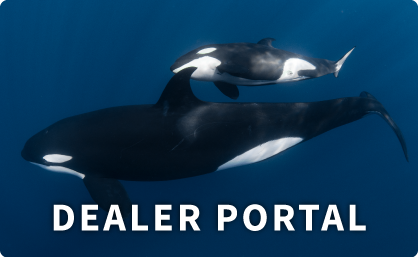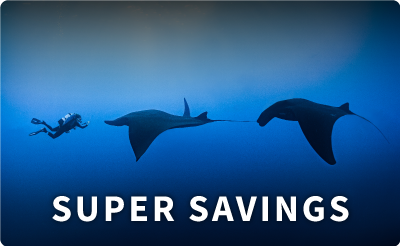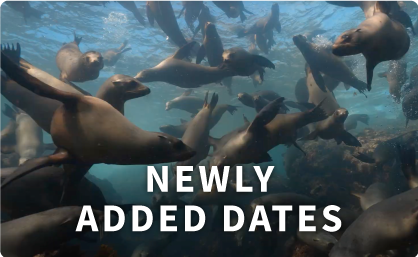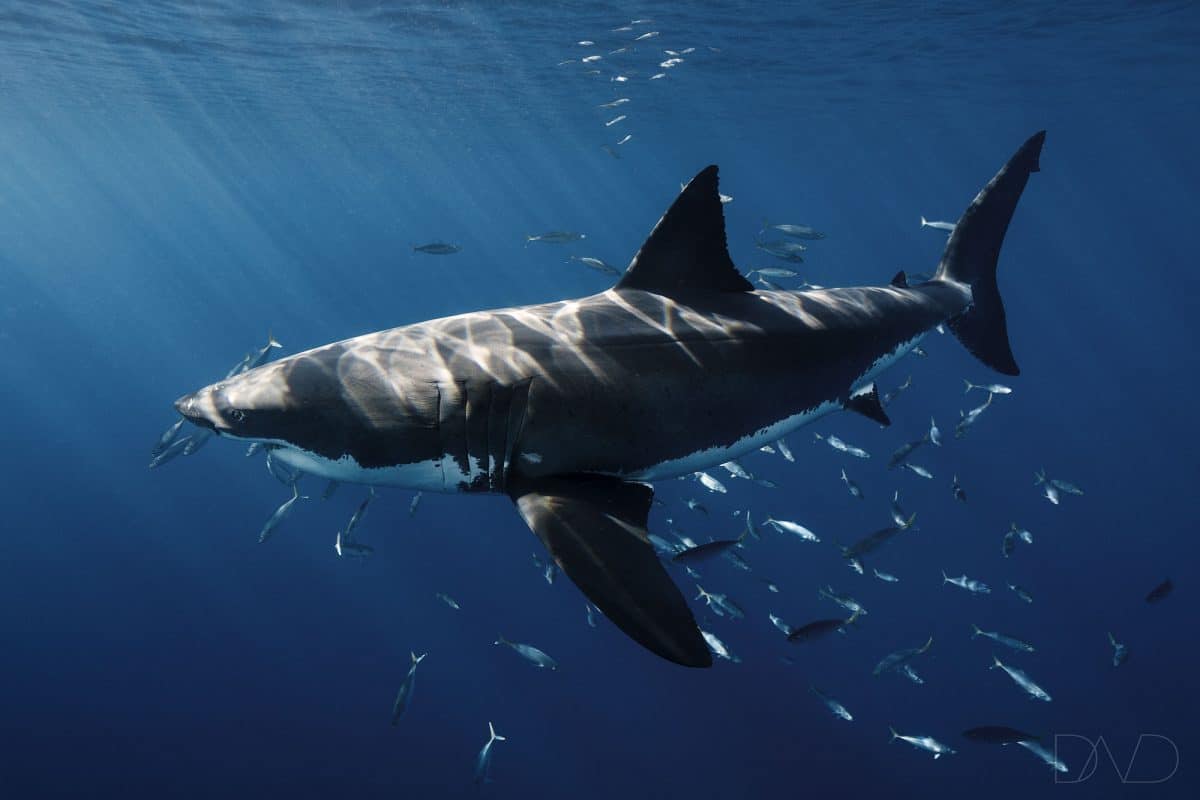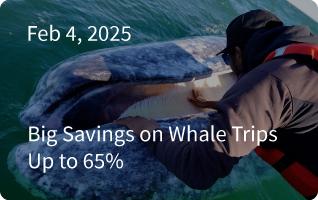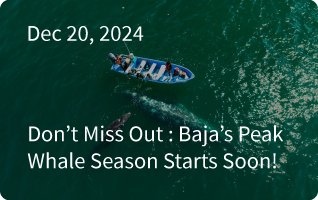A Baby Great white shark measures 5 feet long at the time of its birth. The pup will grow to be an apex predator, but before reaching full size, the pup will have to avoid bigger predators. Sadly the survival of baby great white sharks are very low, and the majority of them do not reach maturity.
Guadalupe Island provides an ecosystem so rich that is able to support the greatest of the oceanic predators- the great white shark. The white sharks undergo a very delicate migration cycle that we are only starting to comprehend.
The juvenile great white sharks that we see each August and September in the waters surrounding Guadalupe Island are a delight for divers seeking for thrill and action. These young male sharks can be easily recognized by their fierce swimming style and explosive behaviour when pursuing the bait on the surface. Just beyond the protected waters of the archipelago lies one of the most critical habitats of the Northeast Pacific population of great white sharks. The waters of Vizcaino Bay and Cedros Island contain the genetic hope that the species will need to survive the Holocene extinction
The life cycle of the great white is poorly understood, and it seems that each population of these sharks makes different use of space and time during their migrations. We are now able to describe better the movement of the white shark population of Central California and Mexico.
Juvenile Sharks tend to stay close to shore until they reach an average size of 1.8m (5ft). Sharks from Baja California, Mexico make their first migration from their nursery grounds to Guadalupe Island and remain there for as long as 14 months, taking advantage of the biodiversity on the island.
This is the risky moment when their lives are in the hands of opportunist fisheries!
Guadalupe Island protection measures won’t be effective if the shark’s migration routes are exposed to fishing activity. This is, unfortunately, the death toll that marine species pay when they travel. The Marine Corridor of the Eastern Tropical Pacific Project (CMAR) is the first regional initiative aiming to protect the boundaries of national parks. This comes in handy when we take into account the efforts put forth by modern industrial fishing fleets. This year we have witnessed the advance of over 200 fishing vessels exploiting the resources just at the edge of the Galapagos Archipelago.
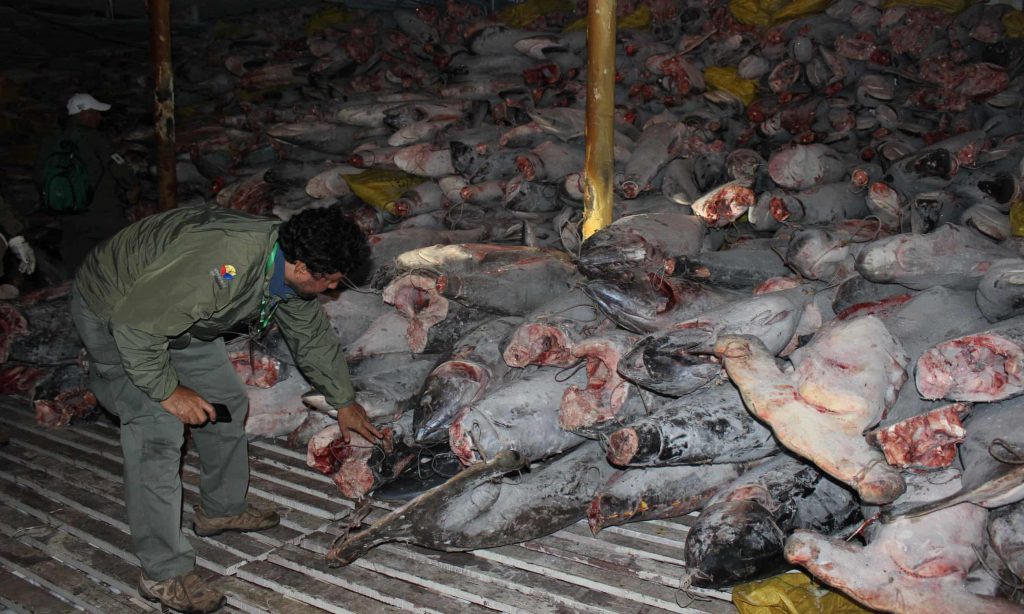
This situation worsens as the COVID-19 pandemic has shut down cage-diving activities on Guadalupe Island. The constant movement of diving liveaboards from July to November functions as a repellent against furtive fisheries , without their presence, the known population of over 300 identified sharks in Guadalupe could be wipe out in one single day.
How can we minimize threats and protect the white shark population?
Researchers from the Monterey Bay Aquarium and the Ensenada Center for Scientific Research and Higher Education (CICESE) are focusing on education and communication with the local fishing communities. Gill nets used by fishermen to catch halibut and other bottom-dwelling species are the biggest threat to the population of newborn sharks from Vizcaino Bay. The mortality rate of juvenile sharks from the Northeast Pacific population is 37%, and more sustainable fishing practices would reduce the impact of artisanal fisheries in Baja California. White sharks are very resilient, so if fisherman increases their frequency with which they are checking their gill nets, a shark that was recently captured could be released on time and have a better chance of survival.
Sharks like great whites are not naturally designed for quick reproduction. They birth few pups compared to other shark species- whale sharks, for example. An average female white shark gives birth to 2-10 pups in comparison to 300 whale shark pups. Then, the newborn pups will take between 10 to 16 years to reach maturity. The only way to ensure a long term stable population of adults is to protect them until they reach adulthood.
The knowledge acquired from Mexican baby sharks will shed light on the elusive ecology of white sharks and define the priorities of research.
Mummified shark heads found in landfills in Vizcaino have provided substantial DNA evidence required to assess populations. Sharks from the Northeast Pacific differ widely from Australian sharks, though there is little variation among the nursery ground populations from Central California, Southern California, and Baja California.These specimens can also help us to keep track of resource exploitation. Better yet, we hope this data can be used to include Vizcaino Bay on the official list of shark nurseries in Mexico and ensure proper management plans can be enacted for fishing activity in the area.
We will be at Guadalupe Island when shark diving activity resumes, to help our beloved sharks by inspiring people from all over the world to learn about their species and watch wild juvenile sharks in their habitat!
Divemaster, Felipe dos Anjos

